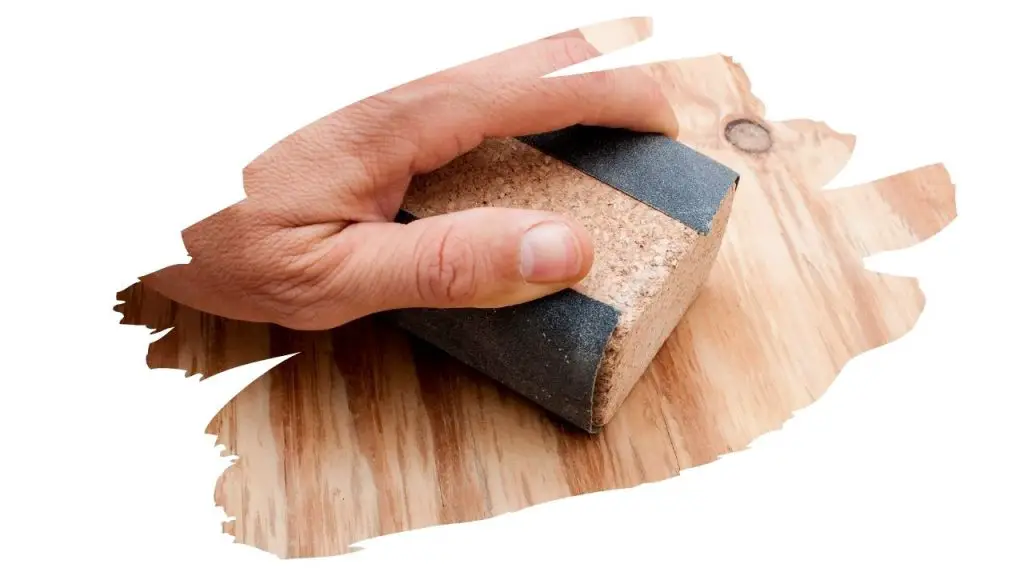If you want your wood project to have the smoothest finish possible, then wet-sanding it is your best bet.
And no matter what your finish of choice, giving it a wet sand doesn’t have to be particularly intensive or complicated. However, wet sanding does require a certain amount of finesse.
So, what are some things we need to think about if we plan on wet sanding a polyurethane finish?
- Using The Right Type Of Sandpaper: Wet sandpaper differs from dry sandpaper in that it does not fall apart when wet.
- Choosing The Right Type Of Lubricant: Your options range from plain water to mineral spirits. But avoid using oil as a lubricant.
- Knowing When To Wet Sand: You don’t want to wet sand a finish that isn’t completely dry and cured.
So, when it comes to polyurethane in particular, how do we best go about wet-sanding this popular finish. Well, keep reading to find out more…

This post may contain affiliate links to products that we receive a commission for (at no additional cost to you). Learn more here.
Can Polyurethane Be Wet Sanded?
Yes, you can wet sand polyurethane. In fact, wet sanding can sometimes be the only way to get a truly smooth polyurethane finish.
This is particularly the case when applying water-based polyurethanes, as they can leave behind a somewhat rough feeling surface. You can learn more about why this happens by reading our post: Why Does Wood Feel Rough After Applying Polyurethane?
But, your timing matters a lot with wet sanding…
Curing Polyurethane: A Waiting Game
The most important aspect of wet-sanding polyurethane is making sure you are wet sanding poly that has completely cured.
That poly finish may look and feel dry in a matter of days – or even hours. But curing takes a lot longer.
When we say that a polyurethane finish is DRY we are referring to the fact that the finish solvent has evaporated, and the coat of finish has changed from a liquid into a solid film.
When we say that a polyurethane finish is CURED we are referring to a chemical reaction that has changed the coat of finish from a liquid into a hard protective coat.
If you are going to wet-sand wood you need to give the polyurethane enough time to cure, and not simply just wait for it to dry.
But as long as the polyurethane has cured, then yes, you can wet sand it.
Related Post: What Can You Do When Your Polyurethane Finish Is Too Shiny?
So, How Long Should Polyurethane Dry Before Sanding?
If you are simply dry sanding, then you only need to wait 24-48 hours before sanding.
However, if you are wet sanding, then you need to make sure you’ve waited long enough for the finish to completely cure.
Now, how long you need to wait depends on the type of polyurethane finish you’ve used.
There are two types of polyurethane finish; water-based and oil-based.
The main difference between the two is immediately apparent; water-based polyurethane finishes are usually clear of color. Whilst oil-based polyurethane have an amber hue that darkens over time.
Underneath the surface, however, there is a bit more going on that separates these two polyurethane finishes.
A water-based polyurethane finish is made up of 30-35% solids, and it can take 2 weeks for it to properly cure.
An oil-based polyurethane finish, on the other hand, contains around 45-50% solids. This finish type can take up to 30 days to cure.
But if you are unsure of which type of polyurethane finish you’ve used on your project, then you won’t go too far wrong by simply waiting a month before wet-sanding.
As they say, patience is a virtue. And playing the waiting game in this instance will pay off later on.
What Is The Purpose Of Sanding Between Coats Of Polyurethane? Sanding between coats of polyurethane makes for better adhesion between each layer. This helps make the finish more level and smooth. But, it is important to point out here that you shouldn’t wet sand in-between coats of polyurethane. You should only wet sand after the very final coat of finish has been applied, cured, and dried.
Related Post: Why Does Wood Feel Rough After Applying Polyurethane?
Do You Need Special Sandpaper For Wet Sanding?
Yes you do. There is a special type of sandpaper specifically made for wet sanding.
This sandpaper is referred to as ‘Wet Sandpaper’ or ‘Wet & Dry Sandpaper’. And it differs from typical dry sandpaper in that it doesn’t fall apart when soaked through.
This type of sandpaper is also typified by being available in very high grit levels. You can buy wet sandpaper at 200, 500, or even 5,000 grit levels or higher.
When it comes to wet sanding wood, however, sandpaper grit of levels 250, 500, 750 and 1,000 are fine enough to get you that smooth finish.
Related Post: What Causes Fuzzy Wood After Sanding? (And How To Fix It)
Can You Wet Sand With Mineral Spirits?
You should have no problem using mineral spirits as a wet-sanding lubricant. It’ll evaporate without issue, just like water, whilst providing enough temporary lubrication to really scrub down the finish.
Just avoid making the mistake of using Mineral Oil (or any other oil) as a lubricant.
Will Mineral Spirits Harm Polyurethane? Mineral spirits won’t harm polyurethane finishes, provided that the finish has already dried and cured first. Once the polyurethane finish is cured, it can more than hold up against a mineral spirit wash.
So, How Do You Smooth The Final Coat Of Polyurethane?
Wet Sanding Polyurethane (A Quick & Easy Guide):
- Check The Finish Has Cured
Since much of the curing process occurs underneath the finish, it can be difficult to be sure. So the best method for checking the finish has cured is to simply wait and give that final coat 30 days before you start wet sanding.
If your polyurethane finish isn’t drying there are a few things you can try to help speed things along. You can learn all about them right here on The Woodwork Place by reading our post here: Polyurethane Not Drying? What You Can Do To Fix It
- Dry Sand The Finish
Dry sand the finish first with 80 grit sandpaper, going over the finish using small circular movements. Go over the surface again, but this time with 100 grit sand paper. And then again, once more, with 120 grit sandpaper.
- Before You Start, Wipe It Down
Once the surface feels relatively smooth to the touch, wipe it down with a tack cloth or a clean damp rag. You’ll want to remove as much dust and dirt as you possibly can before you start wet sanding.
- Purchase Wet Sandpaper (or Wet & Dry Sandpaper)
Wet sandpaper differs from typical dry sandpaper in that it does not fall apart when soaking wet. Wet sandpaper can also be purchased in much higher grit levels too. Which is very important if you want to get that perfectly smooth finish. You can get wet sandpaper from all good hardware stores.
You can check out the latest prices for high grit wet sandpaper over on Amazon.
- Soak The Sandpaper
Starting with 250 grit sandpaper, soak the wet sandpaper for 30 minutes in a lubricating solution. Ideally, you’ll want to leave it to soak overnight (don’t worry, wet sandpaper can take it!).
What Can I Use As A Wet-Sanding Lubricant? Plain water or dish detergent soapy water will do as a lubricant. You can also opt for using mineral spirits too.
- Create A Wet Sanding Block
When you are ready to begin wet sanding, wrap the soaked sandpaper around a small block of wood. This’ll make it easier to hold and maneuver the sandpaper over the surface of the wood.
- Begin Wet Sanding
Make small circular movements over the surface of the wood. Also, make sure that the surface you are sanding is wet too. Running soaked sandpaper over a bone dry finish will only cause more scuff problems than it fixes.
- Sand, Check, Then Sand Again
When you sand a particular area, you will only need to run over it a couple of times before pausing to check how smooth it is. This is time consuming, but worth it. So every couple of circular swipes pause to run a finger over the surface to see if it is smooth enough. If not, go back over it again once more. Keep going until you’ve gone over the entire surface.
- Increase The Grit, Then Sand Again
Once done, run your hand over the surface. Is it as smooth as you’d like it to be? Well, then you can call it a job done. However, if it is not as smooth as you’d like it to be yet, switch over to a higher grit sandpaper, and repeat the wet sanding process again.
Related Post: Are There Dust Nibs In Your Polyurethane Finish? (How To Fix It)
Final Thoughts
So there you have it! Wet sanding can seem a bit complicated at first, but it really isn’t.
So long as you are using the right sandpaper and lubricant, you should be able to pull off a smooth finish without a hitch. Just be sure you;
- Wait for the polyurethane finish to cure. If you aren’t sure, then wait 30 days before you start wet sanding.
- Avoid using any oil-based lubricants. Just stick to water or a dish detergent + water mix. Mineral spirits will do at a pinch as well.
- Use wet sandpaper (or wet & dry sandpaper) to wet sand with. These special sandpaper types don’t fall apart when drenched in water.



